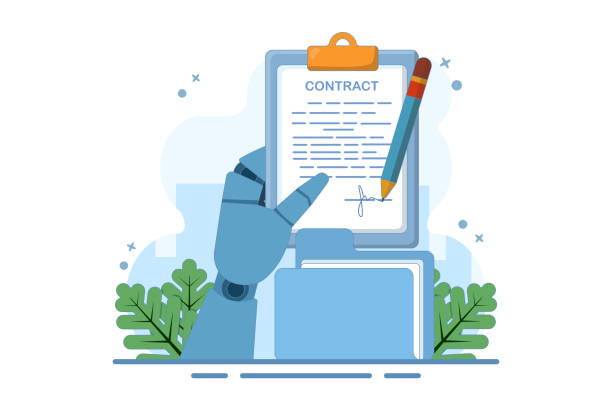Introduction to the Multilingual World of the Web

In today’s world, where geographical boundaries have less meaning, digital presence has gained unprecedented importance.
With the expansion of internet access worldwide, the concepts of #globalization and #cultural_navigation have become more prominent than ever.
A website available in only one language misses a large part of its potential audience. This is where the importance of multilingual website design becomes apparent.
Multilingual websites not only enable businesses to reach new markets but also provide a richer user experience for visitors.
In fact, this approach means going beyond mere translation and entering the world of #localization, where content is adapted for different audiences not only linguistically but also culturally.
This chapter provides an explanatory and educational overview of this concept and lays the foundations for understanding its necessity.
Having a multilingual website is not just a competitive advantage; in many cases, it has become a necessity.
This allows companies to connect with consumers worldwide, build their trust, and ultimately achieve sustainable growth and development.
Is your current website displaying your brand’s credibility as it should? Or is it driving away potential customers?
Rasawab, with years of experience in professional corporate website design, is your comprehensive solution.
✅ A modern, beautiful website tailored to your brand identity
✅ Significant increase in lead generation and new customers
⚡ Contact Rasawab now for a free consultation on corporate website design!
Why Does Your Business Need a Multilingual Website?

One of the fundamental questions for any business in the current era is whether investing in multilingual website design is economically justifiable? The answer to this question is often a resounding “yes.”
From an analytical perspective, the globalization of the economy and easy access to information have intensified the need for cross-border communication.
Many users prefer to interact with websites that provide services in their native language. This not only helps in better understanding the content but also builds a greater sense of trust and closeness between the user and the brand.
Multilingual websites allow you to access markets that were previously inaccessible.
This includes potential customers in different countries, or even immigrant communities within your own country who speak other languages.
Furthermore, Search Engine Optimization (SEO) for multilingual websites also offers significant advantages.
Google and other search engines value high-quality, multilingual websites, which can lead to better rankings in search results for various keywords in different languages.
This capability greatly expands your website’s reach, leading to increased traffic and, ultimately, a higher customer conversion rate.
Therefore, overlooking the importance of creating a multicultural website can mean missing out on unique opportunities for growth.
Key Considerations in Multilingual Website Design

When planning multilingual website design, numerous technical, design, and cultural aspects must be carefully considered.
This section specifically and guidance-wise addresses these points.
Choosing the appropriate URL structure (subdirectory, subdomain, or top-level domain) for each language is highly important and has a direct impact on SEO.
The use of hreflang tags is essential for informing search engines about different language versions of a page.
Furthermore, the design of the User Interface (UI) and User Experience (UX) must be adaptable to different text orientations (e.g., right-to-left for Persian and Arabic, left-to-right for English) as well as cultural differences in the use of colors, images, and symbols.
User experience on multilingual websites should be such that users can easily select their desired language and benefit from visual and efficient navigation.
Content management is also a significant challenge; there must be a system that allows for easy content updates in all languages.
These considerations can be summarized in the table below:
| Area | Considerations | Importance |
|---|---|---|
| Technical | URL structure (subdirectory, subdomain), hreflang tags, Unicode support | Very high (SEO and performance) |
| Design and User Experience (UX/UI) | RTL/LTR support, font selection, local colors and icons | Very high (user interaction and acceptance) |
| Content Management | Multilingual-compatible Content Management System (CMS), translation workflow | High (maintenance and updates) |
| Localization | Translation beyond words, adaptation to local culture, currency and date formats | Very high (trust and communication) |
Choosing the Right Strategy for Website Multilingualism

When deciding on multilingual website design, one of the first important decisions is choosing the appropriate URL strategy for displaying different languages.
This choice not only affects how the website address is displayed but also impacts international SEO and user experience.
There are three main options: using country-specific top-level domains (gTLDs) (e.g., .de for Germany, .fr for France), subdomains (e.g., fr.example.com), and subdirectories (e.g., example.com/fr/).
Each of these methods has its own advantages and disadvantages, and choosing the best option depends on your business goals, budget, and resources.
Country-specific top-level domains are the best option for targeting a specific country and give stronger signals to search engines, but they are more expensive and more complex to manage.
Subdomains can also be useful for separating linguistic content, while subdirectories are generally cheaper and simpler to implement and benefit from the main domain’s authority.
This section provides an educational and guidance-oriented comparison of these strategies to help you make an informed decision.
It is crucial to carefully review these strategies and consult with SEO specialists before beginning any development to ensure the correct choice.
Any mistake at this stage can harm your website globalization efforts.
Is your current e-commerce website not generating the sales you expect?
Rasawab specializes in professional e-commerce website design!
✅ An attractive and user-friendly website aimed at increasing sales
✅ High speed and security for an ideal shopping experience⚡ Get a free online store design consultation with Rasawab!
Content Translation and Localization Beyond Words

Creating a multilingual website is not just about word-for-word translation of texts.
In fact, content localization is a more complex and vital process that involves thoroughly adapting content to the culture, customs, humor, and even thought patterns of the target audience in the destination language.
This section specifically addresses the importance of this topic.
A purely literal translation can be inaccurate, meaningless, or even offensive. For instance, colors, symbols, idioms, dates, currency, and even the way business concepts are expressed must be localized with high precision.
This process requires translators who are not only fluent in both languages but also have a deep understanding of the target cultures.
Using native speakers who live in the target country can significantly improve the quality of localization.
Furthermore, optimizing keywords for each language and culture, considering how local users search, is of great importance.
Successful localization can significantly increase user engagement, build their trust, and help your business quickly establish a foothold in new markets.
Without proper localization, even the best multicultural website design may not realize its full potential.
Search Engine Optimization (SEO) for Multilingual Websites

One of the most important aspects of successful multilingual website design is ensuring its visibility to search engines worldwide.
This section provides specialized and guidance on SEO strategies for multilingual websites.
Correct use of hreflang tags is one of the most fundamental and crucial SEO actions for multilingual websites. These tags help search engines like Google understand which version of a page is intended for which language or geographical region, preventing duplicate content issues.
International targeting in Google Search Console is also a useful tool for specifying the target country or region for each language version of the website.
Furthermore, keyword research should be conducted separately for each language; as keywords and search phrases can vary significantly across different languages and cultures.
Internal linking between related language versions and acquiring backlinks from authoritative websites relevant to each language can also help improve SEO rankings.
Page loading speed in each geographical region and website responsiveness across different devices are also important factors affecting overall SEO.
Ignoring these tips can lead to reduced visibility of your website in search results, even if you have created the best multilingual portal.
This process requires a continuous approach and performance monitoring to achieve the best results.
Practical Tools and Platforms for Multilingual Website Management

Implementing and managing a multilingual website can be challenging, but today, numerous tools and platforms exist to simplify this process.
This section provides an explanatory and educational introduction to some of these tools.
Content Management Systems (CMS) like WordPress with plugins such as WPML or Polylang, as well as Drupal and Joomla, offer powerful tools for creating and managing multilingual content. These plugins allow for the translation of posts, pages, categories, and even menus.
In addition to CMSs, Translation Management Systems (TMS) also exist to optimize the translation process.
These systems enable translators to organize content and translate it with high quality and greater speed by leveraging Translation Memories and glossaries.
Automated translation tools like Google Translate API can also be useful for initial drafts or less critical content, but for sensitive or marketing content, professional human translation and localization are essential.
The choice of the right platform depends on the project’s scale, budget, and your business’s specific needs.
Some of these tools also offer features such as visual editors for translation, translation quality checks, and translation project management, which significantly streamline the multicultural website design process.
The table below outlines some of these tools and their features:
| Tool/Platform Type | Examples | Key Features |
|---|---|---|
| Content Management Systems (CMS) | WordPress (with WPML/Polylang), Drupal, Joomla | Multilingual content management, translation plugin capabilities, URL structuring |
| Translation Management Systems (TMS) | MemoQ, SDL Trados Studio, Smartcat | Translation memory, glossary, translation project management, team collaboration |
| Automatic Translation Services | Google Translate API, DeepL API | Machine translation, high speed, low cost (for initial or non-sensitive translation) |
| Localization Platforms | Localise, Transifex | Content string management for developers, translator collaboration, API |
Common Challenges in Multilingual Website Design and Solutions

Implementing multilingual website design, despite its many advantages, is not without challenges.
This section, in a thought-provoking and guidance-oriented manner, examines some common problems and provides practical solutions for them.
One of the biggest challenges is ensuring the quality and accuracy of translation. Machine translations may be fast, but they often lack precision, cultural nuances, and appropriate tone.
The solution is to always use native, professional human translators and include a thorough review process.
Another challenge is managing updated content; how do you ensure that all language versions are updated in a timely manner? Using a powerful CMS with translation management capabilities and setting up a translation workflow can facilitate this process.
Problems related to international SEO, such as choosing the wrong URL structure or incorrect use of hreflang tags, can lead to lower search engine rankings.
Educating the development team and SEO specialists on best practices and using SEO monitoring tools is essential.
Additionally, you may encounter technical challenges such as Unicode support for different languages, specific fonts, or Right-to-Left (RTL) orientation.
Close collaboration with experienced developers and using modern web frameworks that support these capabilities can help resolve these issues.
Finally, understanding cultural differences and preventing localization errors is also a crucial challenge that requires deep research and understanding of the target audience.
A comprehensive and well-planned approach is key to overcoming these obstacles in the path of multilingual website development.
Is your e-commerce website ready to attract maximum customers and increase sales? Rasawab transforms your online business with modern and efficient e-commerce website designs.
✅ Increased speed and improved SEO
✅ Excellent user experience on mobile and desktop⚡ Get a free e-commerce website design consultation from Rasawab!
Future Trends in Multilingual Websites and Globalization

The future of multilingual website design is intertwined with technological advancements, especially in artificial intelligence and machine learning.
This section provides a news-oriented and analytical look at emerging trends that will revolutionize the formation of multilingual websites in the future.
One of the most significant trends is the remarkable progress in Neural Machine Translation (NMT). These technologies can provide much more accurate and fluent translations, increasingly approaching the quality of human translation.
This means that in the future, initial translations can be generated more quickly and then reviewed by human translators for final localization and refinement.
Voice search and smart assistants will also play a prominent role in the future of multilingual websites.
Websites must be optimized to respond to voice queries in various languages, which requires a deep understanding of speech patterns and common phrases in each language.
Augmented Reality (AR) and Virtual Reality (VR) may also provide richer and more multilingual experiences for users.
Content-driven and video platforms are also moving towards offering automatic subtitles and dubbing in multiple languages.
These trends indicate that the importance of multilingual website design will not only not diminish but will take on new dimensions with technological advancements, making global interactions easier and more natural.
Companies must be prepared to embrace these changes to remain leaders in global competition.
Indirect and Hidden Benefits of Website Multilingualism

Beyond the obvious benefits of accessing new markets and improving SEO, multilingual website design offers indirect and often hidden advantages that can significantly impact a business’s success.
This section, in an engaging and explanatory manner, delves into these less-observed points.
One such advantage is the enhancement of brand reputation and credibility. Providing content in a user’s native language demonstrates your respect for their culture and needs, which can lead to greater customer loyalty and create a positive brand image.
This is a small yet highly impactful gesture that shows you value your global audience.
Furthermore, multilingual websites can also be effective in attracting international talent.
If you are looking to expand your team with individuals from diverse cultures and languages, a website that is available in multiple languages indicates that your company fosters a diverse and inclusive work environment.
This can create a competitive advantage in the recruitment process.
Additionally, access to feedback and opinions from various linguistic communities can provide valuable insights for improving your products and services.
These international insights, gained through multilingual interactions, can contribute to innovation and the development of new strategies.
Ultimately, building a multilingual website helps you gain a better understanding of global markets and acquire new knowledge and perspectives through cultural interactions, which aids in the growth and evolution of your business.
Frequently Asked Questions
| Question | Answer |
|---|---|
| What is multilingual website design? | The process of creating a website whose content is available to users in more than one language. |
| Why should we make our site multilingual? | To reach a broader global audience, improve user experience for non-native speakers, and increase sales or engagement. |
| What are the methods for implementing a multilingual site? | Using subdomains, subdirectories, or URL parameters, or using different Top-Level Domains (TLDs) for each language. |
| Which method is better for SEO? | Generally, using subdirectories (e.g., example.com/fa/) is recommended for SEO, as they share the main domain’s authority. |
| What is the hreflang tag and what is its use? | The hreflang tag is an HTML attribute that helps search engines understand which version of a page is suitable for a specific language or region. |
| Is machine translation sufficient for multilingual website content? | Usually no. Professional translation and content localization are essential for providing a good user experience and maintaining credibility. |
| What does Localization mean? | The process of adapting the content, design, and functionality of a site to the culture, language, currency, and other specific characteristics of a target region or country. |
| What is the importance of language selection in multilingual website design? | Users should be allowed to easily select their desired language, typically via a clear button or menu in the site’s header. |
| What challenges exist in multilingual website design? | Managing content in different languages, maintaining design and user experience consistency, multilingual SEO, and translation and maintenance costs. |
| What features should a suitable Content Management System (CMS) for a multilingual site have? | It should allow for easy content management in different languages, support multilingual URL structures, and have relevant translation and localization plugins. |
And other services of Rasa Web Advertising Agency in the field of advertising
Smart Conversion Rate Optimization: A fast and efficient solution for digital branding focusing on SEO-driven content strategy.
Smart UI/UX: An effective tool to increase website traffic with the help of marketing automation.
Smart Marketplace: An innovative platform for improving customer acquisition with intelligent data analysis.
Smart Sales Automation: Revolutionize campaign management with Google Ads management.
Smart Advertising Campaign: A fast and efficient solution for improving SEO ranking with a focus on precise audience targeting.
And over hundreds of other services in the field of internet advertising, advertising consultation, and organizational solutions
Internet Advertising | Advertising Strategy | Advertorial
Sources
The Importance of Multilingual Website Design
Advantages of Multilingual Website Design
Multilingual Site SEO
The Future of Multilingual Website Design
? In today’s digital world, your business’s success is just a click away. Rasawab Afarin, by providing comprehensive digital marketing services including custom website design, SEO, and social media management, paves your way to visibility. With us, your brand will shine at its peak.
📍 Tehran, Mirdamad Street, next to Bank Markazi, Southern Kazeroon Alley, Ramin Alley, No. 6

